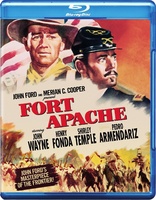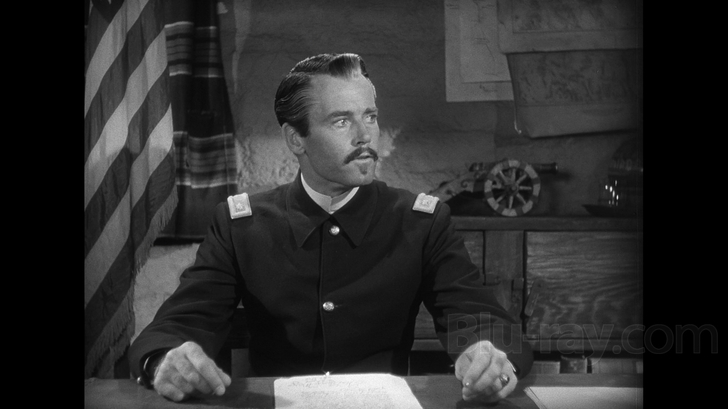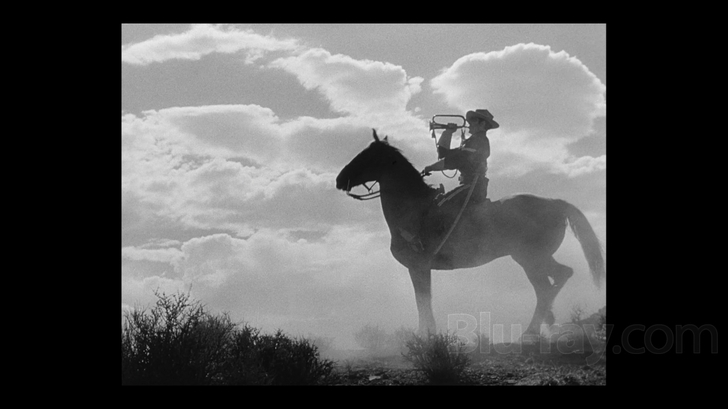Fort Apache Blu-ray Movie
HomeFort Apache Blu-ray Movie 
Warner Bros. | 1948 | 128 min | Not rated | Feb 21, 2012
Movie rating
7.8 | / 10 |
Blu-ray rating
| Users | 3.7 | |
| Reviewer | 4.0 | |
| Overall | 3.7 |
Overview
Fort Apache (1948)
The men at Fort Apache don't like their new commander. But they're duty-bound to obey, even when it means disaster.
Starring: John Wayne, Henry Fonda, Shirley Temple, Pedro Armendáriz, Ward BondDirector: John Ford
| Western | Uncertain |
| Romance | Uncertain |
| Adventure | Uncertain |
| Action | Uncertain |
Specifications
Video
Video codec: MPEG-4 AVC
Video resolution: 1080p
Aspect ratio: 1.37:1
Original aspect ratio: 1.37:1
Audio
English: DTS-HD Master Audio Mono (48kHz, 24-bit)
Spanish: Dolby Digital Mono
Subtitles
English SDH, French, Spanish
Discs
25GB Blu-ray Disc
Single disc (1 BD)
Playback
Region free
Review
Rating summary
| Movie | 4.5 | |
| Video | 3.5 | |
| Audio | 3.0 | |
| Extras | 2.5 | |
| Overall | 4.0 |
Fort Apache Blu-ray Movie Review
If he's Thursday, this must be Fort Apache.
Reviewed by Jeffrey Kauffman February 16, 2012Fort Apache has an unusual credits sequence that provides snippets of the story to come, almost like those Marvel Comics flip page summaries of film adaptations that play out before the film even starts. What accompanies some of this opening montage is perhaps even more interesting, if perhaps not quite as unusual—namely, Richard Hageman’s underscore, which quickly segues from the overt heroism of a United States Cavalry bugle call to ominous parallel fifths every time Indians (as they were called back then) appear on the screen. Is Fort Apache going to be a standard American cowboys and Indians shoot ‘em up where the cowboys wear white hats and the Indians wear black headdresses? The music may be deliberately misleading, or more probably simply is falling into that era’s standard operating motifs, for while the score may paint a world of blacks and whites, Fort Apache is one of the most fascinating, bracingly original Westerns to ever have been filmed. John Ford’s oeuvre is filled with subtle revisions of accepted Western norms, sometimes so subtle that casual viewers often tend to only focus on the more expected, iconic elements that are undeniably also a part of Ford’s technique. But even a cursory peek beneath the surface of just about any of Ford’s Westerns reveals a roiling world of tumultuous human emotions and interrelations, elements which squarely defy being categorized as purely heroic or purely villainous. Certainly that’s the truth with Fort Apache, one of Ford’s most fondly remembered pieces, and the first in what would become known as the director’s Cavalry Trilogy (the other two are She Wore a Yellow Ribbon and Rio Grande). This is a piece that humanizes its Native Americans and actually demonizes some of the American soldiers and hangers-on who are frankly encroaching on the Native Americans’ homeland. Even more fascinatingly, Fort Apache paints several main characters with shades of gray which may not conveniently fit into audiences’ preconceptions about how “good guys” or “bad guys” should act or find their motivations, but which instead invest them with a really rare amount of visceral intensity and realism.

Ford and scenarist Frank S. Nugent (adapting a Saturday Evening Post short story by James Warner Bellah) get right to the heart of what typically makes most Westerns such rousing fare, namely the audience’s tendency to lionize heroes, typically the “good guy” cowboys or, in this case, United States military. And yet what Fort Apache does so impeccably well in an almost surreptitious piece of subterfuge is recast the entire zeitgeist of the Western in a decidedly (and completely prescient and unexpected) post-modernist light. The film takes place in the aftermath of the Civil War, when Americans had finally stopped killing each other and could focus more squarely on dealing with (which frankly often meant killing) the Native American “savages.” Fort Apache opens with the arrival of martinet Lt. Col Owen Thursday (Henry Fonda in one of his most unusual roles, about which more later) and his daughter Philadelphia (Shirley Temple). (That’s director John Ford’s brother and frequent bit player Francis Ford as the mustachioed stagecoach driver in the opening scene.) Thursday has been assigned to command Fort Apache, a Godforsaken outpost in the nether regions of the American West, and one which keeps a precarious peace with Cochise’s tribe.
The uptight Thursday is counterbalanced by the laid back Capt. Kirby York (John Wayne), who once expected to take command of Fort Apache. The central tension in Fort Apache stems from Thursday’s insistence that the Indians can only be dealt with by force, while York prefers a more collaborative effort that will be, to use modern parlance, a win-win for everyone. Thursday’s increased dogmatism leads to a tragic conclusion (at least for some), but what is so fascinating about Nugent’s screenplay and Ford’s staging of the film is that this very dogmatism is shown to spring from noble, albeit completely misguided, intentions. Thursday is not a typical “villain,” he is more like a figure out of Greek tragedy, a supposed “hero” completely unaware of his own self-inflicted stupid decisions.
A lot of people have completely missed the point of Fort Apache through the years, claiming it’s anti-Indian, when nothing could be further from the truth. While a despicable Indian agent (Grant Withers in what was probably the best performance of his underrated career) may have strangely led to this misapprehension, the film is actually an indictment of knuckleheaded American responses to Native Americans. This very slightly veiled revision of the Custer story is a cautionary tale alerting the perspicacious viewer to the dangers of over-glorifying “heroes” when those very “heroes” are flawed individuals, to say the least. Those who claim not to understand York’s “about face” in the film’s closing moments miss this central thesis of Ford and Nugent’s bold reassessment of what it means to elevate someone onto a pedestal that they perhaps don’t belong on to begin with.
Despite the really admirable realism at the core of Fort Apache, the film can’t quite escape its era and some minor missteps. A subplot between Temple and a “lower class” soldier (John Agar, Temple’s husband at the time) plays into Ford’s frequent examination of the strata of male relationships. In Fort Apache that boils down to what is probably the film’s most cartoonish and least appealing aspect, with enlisted men running around getting drunk while the officers debate the fine points of slaughtering Native Americans. Vocalist Dick Foran is also on hand crooning some Irish songs, which seems an odd interpolation into an otherwise gritty dramatic piece.
Perhaps the most surprising thing about Fort Apache, at least for those who have a view of Henry Fonda as inerrantly (and inherently) noble and decent (think Tom Joad in The Grapes of Wrath), is his depiction of an incredibly tightly wound and viciously single minded commander. This is a side of Fonda that was rarely exploited on screen, and the actor is extremely compelling in this unusual role. As commentator F.X. Feeney mentions, when Peter Fonda is asked what his famous father was really like, he typically asks his questioner if they’ve ever seen Fort Apache. It’s a not very flattering assessment of the elder Fonda’s parenting abilities, but it may ironically point out what a master actor the man must have been in all of those other kinder, gentler roles.
Fort Apache Blu-ray Movie, Video Quality 

Fort Apache is presented on Blu-ray courtesy of Warner Brothers with an AVC encoded 1080p transfer in 1.37:1. While this transfer isn't up to the incredible standards of some of the other Warner classics of this era, it holds its own, especially since it appears to have been sourced from a print and not a fine grain master positive or original negative. The print is largely damage free, though there are occasional very minor emulsion issues (the opening few seconds are the worst), occasional white flecks and scratches, and some slight variations in contrast. Generally, though, the image is decently sharp and well detailed, though I personally would have liked richer blacks. Oddly, a few scenes are noticeably softer than the bulk of the film, and there doesn't seem to be any logical reason for it; some of these are location shots (which would be understandable), while others are obvious from the studio bound segments. Grain is natural looking, perhaps a bit on the unexpectedly minimal side (considering the film's age and this transfer having evidently been sourced from a print), but does not appear to have been artificially reduced. The location photography in Ford's beloved Monument Valley offers some spectacular depth of field and remains one of the stronger visual elements of both the film and this high definition presentation.
Fort Apache Blu-ray Movie, Audio Quality 

Fort Apache's original mono soundtrack is presented in a decent sounding lossless DTS-HD Master Audio 1.0 mix. The soundtrack is obviously a relic of a bygone age, and has not aged particularly well, with an overall boxy sound that is especially noticeable in the film's many music cues. Higher frequencies are slightly clipped, and the low end, while certainly present (and perhaps even a bit surprisingly so), still remains a bit muddled. Midrange frequencies sound the best here, which means the dialogue comes across cleanly and clearly, if again slightly boxy sounding. Fidelity is certainly fine given an understanding of the age of the track, and dynamic range is rather good, again taken in the proper context.
Fort Apache Blu-ray Movie, Special Features and Extras 

- Commentary by F.X. Feeney is quite informative, if also a bit on the monotonous side, at least from a delivery angle. Feeney reveals he may be a long lost cousin of John Ford's, though he readily admits that gives him no special insight into the film. Feeney's commentary gives a wealth of background on the project, but perhaps more importantly, places this film in the overall context of the Western in general and Ford's contributions to the genre in particular.
- Monument Valley: John Ford Country (SD; 14:41) is a nice look at one of John Ford's favorite places for location shooting, Monument Valley, which straddles the border between Arizona and Utah. Ford first utilized the incredible scenery of Monument Valley in Stagecoach, and continued to film there throughout the rest of his career.
- Theatrical Trailer (SD; 1:45)
Fort Apache Blu-ray Movie, Overall Score and Recommendation 

As with many of Ford's Westerns, Fort Apache exists on two completely different levels. Undemanding viewers can simply enjoy it for its depiction of a Wild West where the cavalry fought the Indians, supposedly to the glory of the United States. Those who take the time to really peer beneath the surface will find a completely different film, one which exposes and even undermines the mythology of the hero and which questions the whole notion that history is written by the victors. While this Blu-ray isn't quite up to the spectacular standards of a lot of Warner catalog releases, it still is a joy to see on Blu-ray and comes Highly recommended.
Similar titles
Similar titles you might also like

Rio Grande
1950

The Horse Soldiers
1959

She Wore a Yellow Ribbon
Warner Archive Collection
1949

The Comancheros
1961

The Outlaw Josey Wales 4K
1976

Santa Fe
1951

The Big Trail
1930

The Professionals
1966

Red River
Theatrical and Prerelease versions
1948

Cahill U.S. Marshal
1973

A Reason to Live, A Reason to Die
1972

Rio Lobo
1970

The Iron Horse
Limited Edition to 3000
1924

Distant Drums
1951

Two Rode Together
Limited Edition to 3000 - SOLD OUT
1961

Bend of the River
1952

El Dorado
1966

The Train Robbers
1973

Devil's Doorway
Warner Archive Collection
1950

Only the Valiant
1951